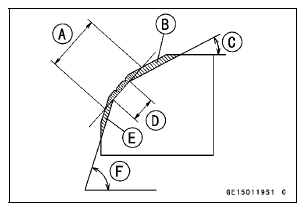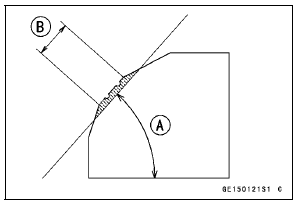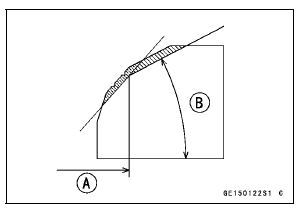

Grind the seating surface only until it is smooth.
NOTICE
Do not grind the seat too much. Overgrinding will reduce valve clearance by sinking the valve into the head. If the valve sinks too far into the head, it will be impossible to adjust the clearance, and the cylinder head must be replaced.
If the outside diameter of the seating surface is too small, repeat the 45¬į grind until the diameter is within the specified range.
Widened Width [A] of engagement by machining with 45¬į cutter
Ground Volume [B] by 32¬į cutter 32¬į [C]
Correct Width [D]
Ground Volume [E] by 60¬į cutter 60¬į [F]

If the outside diameter of the seating surface is too small, repeat the 45¬į grind [A] until the diameter is within the specified range.
Original Seating Surface [B]
NOTE
If the outside diameter [A] of the seating surface is too large, make the 32¬į grind described below.
If the outside diameter of the seating surface is within the specified range, measure the seat width as described below.

To make the 32¬į grind, fit a 32¬į cutter into the holder, and slide it into the valve guide.
Turn the holder one turn at a time while pressing down very lightly. Check the seat after each turn.

NOTICE
The 32¬į cutter removes material very quickly.
Check the seat outside diameter frequently to prevent overgrinding.
After making the 32¬į grind, return to the seat outside diameter measurement step above.
If the seat width is too narrow, repeat the 45¬į grind until the seat is slightly too wide, and then return to the seat outside diameter measurement step above.
If the seat width is too wide, make the 60¬į [A] grind described below.
If the seat width is within the specified range, lap the valve to the seat as described below.
To make the 60¬į grind, fit 60¬į cutter into the holder, and slide it into the valve guide.
Turn the holder, while pressing down lightly.
After making the 60¬į grind, return to the seat width measurement step above.
Correct Width [B]

NOTICE
Do not lap the valve to the valve seat, using the grinding compound. It will come off oxide film treated surface of the valve.

 Seat Cutter Operation Care
Seat Cutter Operation CareKawasaki Intelligent anti-lock Brake System (KIBS,
For models equipped with KIBS)
KIBS regulates anti-lock braking performance
with more precision during
sports riding compared to a conventional
ABS system.
KIBS is designed to help prevent
the wheels from locking up when the
brakes are applied hard while riding
straight. KIBS automatically regulates
brake force using en ...
Intake Air Temperature Sensor Removal
NOTICE
Never drop the intake air temperature sensor especially
on a hard surface. Such a shock to the sensor
can damage it.
Remove the fuel tank (see Fuel Tank Removal in the Fuel
System (DFI) chapter).
Disconnect the connector [A] from the intake air temperature
sensor.
Remove the da ...
For Primary Fuel Injectors
Remove the air cleaner housing (see Air Cleaner Housing
Removal).
Disconnect the primary fuel injector connector [A].
Connect a digital meter to the terminals in each primary
fuel injector [A].
Measure the primary fuel injector resistance.
Primary Fuel Injector Resistance ...